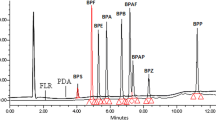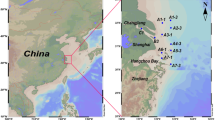Abstract
A method has been developed for the trace analysis of oxypurinol that is considered as an active pharmaceutical ingredient and an emerging environmental contaminant. The method achieved the identification and quantification of oxypurinol in surface water samples utilizing solid phase extraction and ultra high-performance liquid chromatography with diode array and fluorescence detection for the first time. Four principal parameters of solid phase extraction were optimized to obtain maximum extraction efficiency. Under the isocratic elution of methanol/water (5:95, v/v) and the excitation/emission wavelength of 254/359 nm, a rapid determination was achieved in 2.0 min with good linearity of 1.05–351 μg/L (coefficient of determination above 0.9998). The limit of detection and method detection limit were 0.210 μg/L and 1.34 ng/L, respectively. Precision of the method was evaluated and a relative standard deviation value of 3.3% was obtained for analyses of six replicate spiking blank samples (200 mL, 176 ng/L) according to the overall proposed procedure. The method showed a great anti-interference ability and average spiked recoveries of oxypurinol in five surface water samples were in the range of 94.5–111%. The ability of the method to detect and correctly identify oxypurinol can significantly promote investigation on the occurrence of oxypurinol in water and its potential (eco-)toxicological effects.

Quantification of the emerging contaminant oxypurinol in s urface water using SPE/UHPLC-FLD




Similar content being viewed by others
References
Yü TF, Gutman AB. Effect of allopurinol (4-hydroxypyrazolo-(3,4-d)pyrimidine) on serum and urinary uric acid in primary and secondary gout. Am J Med. 1964;37:885–98.
Rundles RW, Elion GB, Hitchings GH. Allopurinol in the treatment of gout and secondary hyperuricemia. Bull Rheumat Dis. 1966;16:400–5.
World Health Organization. 19th WHO Model List of Essential Medicines. 2015.
Day RO, Graham GG, Hicks M, McLachlan AJ, Stocker SL, Williams KM. Clinical pharmacokinetics and pharmacodynamics of allopurinol and oxypurinol. Clin Pharmacokinet. 2007;46:623–44.
Funke J, Prasse C, Eversloh CL, Ternes TA. Oxypurinol—a novel marker for wastewater contamination of the aquatic environment. Water Res. 2015;74:257–65.
Sorell TL. Approaches to the development of human health toxicity values for active pharmaceutical ingredients in the environment. AAPS J. 2016;18:92–101.
Bean TG, Bergstrom E, Thomas-Oates J, Wolff A, Bartl P, Eaton B, et al. Evaluation of a novel approach for reducing emissions of pharmaceuticals to the environment. Environ Manag. 2016;58:707–20.
Daouk S, Chèvre N, Vernaz N, Widmer C, Daali Y, Fleury-Souverain S. Dynamics of active pharmaceutical ingredients loads in a Swiss university hospital wastewaters and prediction of the related environmental risk for the aquatic ecosystems. Sci Total Environ. 2016;547:244–53.
Liu X, Ni XJ, Shang DW, Zhang M, Hu JQ, Qiu C, et al. Determination of allopurinol and oxypurinol in human plasma and urine by liquid chromatography-tandem mass spectrometry. J Chromatogr B. 2013;941:10–6.
Kasawar G, Razzak M, Zaheer Z, Farooqui M. Validated RP-LC-MS/MS method for the simultaneous determination of allopurinol and its major metabolite, oxypurinol, in human plasma. J Liq Chromatogr R T. 2010;34:26–37.
Rathod DM, Patel KR, Mistri HN, Jangid AG, Shrivastav PS, Sanyal M. Simultaneous analysis of allopurinol and oxypurinol using a validated liquid chromatography–tandem mass spectrometry method in human plasma. J Pharm Anal. 2017;7:56–62.
JiJi RD, Booksh KS. Mitigation of Rayleigh and Raman spectral interferences in multiway calibration of excitation–emission matrix fluorescence spectra. Anal Chem. 2000;72(4):718–25.
Kulshrestha P, Giese RF Jr, Aga DS. Investigating the molecular interactions of oxytetracycline in clay and organic matter: insights on factors affecting its mobility in soil. Environ Sci Technol. 2004;38:4097–105.
Magnusson B, Örnemark U. Eurachem guide: the fitness for purpose of analytical methods—a laboratory guide to method validation and related topics. 2nd ed. 2014. Available from http://www.eurachem.org.
US Environmental Protection Agency. Guidelines establishing test procedures for the analysis of pollutants (Appendix B to Part 136—Definition and procedure for the determination of the method detection limit—Revision 1.11): U.S. Code of Federal Regulations. Title 40. 1997.
Author information
Authors and Affiliations
Corresponding author
Ethics declarations
Conflict of interest
The author declares that there is no conflict of interest.
Electronic supplementary material
ESM 1
(PDF 273 kb)
Rights and permissions
About this article
Cite this article
Xu, T. Rapid determination of the emerging contaminant oxypurinol in surface water using solid phase extraction followed by ultra high-performance liquid chromatography with fluorescence detection. Anal Bioanal Chem 409, 7097–7103 (2017). https://doi.org/10.1007/s00216-017-0668-0
Received:
Revised:
Accepted:
Published:
Issue Date:
DOI: https://doi.org/10.1007/s00216-017-0668-0




